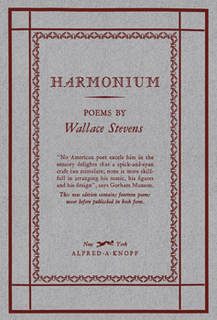Related Research Articles

Wallace Stevens was an American modernist poet. He was born in Reading, Pennsylvania, educated at Harvard and then New York Law School, and he spent most of his life working as an executive for an insurance company in Hartford, Connecticut. He won the Pulitzer Prize for Poetry for his Collected Poems in 1955.

Marianne Craig Moore was an American modernist poet, critic, translator, and editor. Her poetry is noted for formal innovation, precise diction, irony, and wit.

Harmonium is a book of poetry by American poet Wallace Stevens. His first book at the age of forty-four, it was published in 1923 by Knopf in an edition of 1500 copies. This collection comprises 85 poems, ranging in length from just a few lines to several hundred. Harmonium was reissued in 1931 with three poems omitted and fourteen new poems added.
"The Emperor of Ice-Cream" is a poem from Wallace Stevens's first collection of poetry, Harmonium. It was first published in 1922, and is in the public domain. Stevens' biographer, Paul Mariani, identifies the poem as one of Stevens' personal favorites from the Harmonium collection. The poem "wears a deliberately commonplace costume", he wrote in a letter, "and yet seems to me to contain something of the essential gaudiness of poetry; that is the reason why I like it".
"Peter Quince at the Clavier" is a poem from Wallace Stevens's first book of poetry, Harmonium. The poem was first published in 1915 in the "little magazine" Others: A Magazine of the New Verse, edited by Alfred Kreymborg.
"Cy est Pourtraicte, Madame Ste Ursule, et les Unze Mille Vierges" is a poem in Wallace Stevens's first book of poetry, Harmonium. It was first published in 1915 in the magazine Rogue, so it is in the public domain. Butell characterizes it as one of the first two poems to "successfully combine wit and elegance". They are the earliest poems to be collected later in Harmonium.
"Hibiscus on the Sleeping Shores" is a poem from Wallace Stevens's first book of poetry, Harmonium. It was first published in 1921 and is therefore in the public domain.
"O Florida, Venereal Soil" is a poem from Wallace Stevens's first book of poetry, Harmonium. It was first published in the journal Dial, volume 73, July 1922, and is therefore in the public domain.
"Floral Decorations for Bananas" is a poem from Wallace Stevens's first book of poetry, Harmonium (1923). It was first published Measure 26 and is therefore under copyright, however it is quoted here as justified by fair use in order to facilitate scholarly commentary.
"The Weeping Burgher" is a poem from Wallace Stevens's first book of poetry, Harmonium. Originally published in 1919, it is in the public domain.
"The Curtains in the House of the Metaphysician" is a poem from Wallace Stevens's first book of poetry, Harmonium. It was originally published in 1919, so it is in the public domain.
"The Virgin Carrying a Lantern" is a poem from Wallace Stevens's first book of poetry, Harmonium (1923). It was one of the few Harmonium poems first published in that volume, so it is still under copyright. However, it is quoted here as justified by fair use to facilitate scholarly commentary.
"Stars at Tallapoosa" is a poem from Wallace Stevens's first book of poetry, Harmonium. It was first published in 1922, so it is in the public domain.
"Anecdote of the Jar" is a poem from Wallace Stevens's first book of poetry, Harmonium. First published in 1919, it is in the public domain.
"Cortege for Rosenbloom" is a poem from Wallace Stevens's first book, Harmonium. First published in 1921, it is in the public domain in the United States and similar jurisdictions.
"Tattoo" is a poem from Wallace Stevens's first book of poetry, Harmonium. It was originally published in 1916, so it is in the public domain. Librivox has made the poem available in voice recording in its The Complete Public Domain Poems of Wallace Stevens.
The Bird With The Coppery, Keen Claws is a poem from Wallace Stevens's first book of poetry, Harmonium. It was originally published in 1921, so it is in the public domain. Librivox has made the poem available in voice recording in its The Complete Public Domain Poems of Wallace Stevens.
"The Man Whose Pharynx Was Bad" is a poem from Wallace Stevens's first book of poetry, Harmonium. First published in 1921, it is in the public domain in the United States.
"Lunar Paraphrase" is a poem from the second (1931) edition of Wallace Stevens's first book of poetry, Harmonium. One of Stevens's "war poems" from "Lettres d'un Soldat" (1918), it is in the public domain.
"Indian River" is a poem from Wallace Stevens's first book of poetry, Harmonium. It was first published in 1917. Absent from the first edition of 1923, it appeared in the second edition of 1931. It is in the public domain.
References
Moore, Marianne. "Well moused, Lion." The Dial 76 (1924). Reprinted in Twentieth Century Literature 30 (1984).